#kakhovka reservoir
Explore tagged Tumblr posts
Text
烏克蘭卡霍夫卡大壩遭炸毀的後果
周二(6月6號),烏克蘭南部的卡霍夫卡大壩 (Kakhovka Reservoir)…

View On WordPress
2 notes
·
View notes
Text
Kakhovka Reservoir Being Drained
Russia Drains Kakhovka Reservoir
The Kakhovka Reservoir in Ukraine is draining at an alarming rate, and it may be a deliberate Russian tactic to cause a nuclear disaster. The Kakhovka Reservoir is an immense man-made lake (approximately the size of the Great Salt Lake) in southern Ukraine, currently in Russian-occupied territory. It’s one of a series of reservoirs along the Dnipro River, and supplies drinking and irrigation…
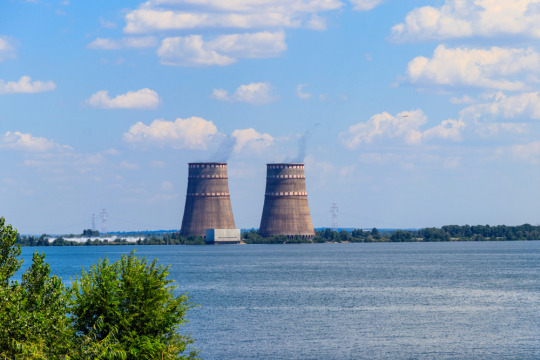
View On WordPress
#hydroelectric dam#kakhovka reservoir#nuclear energy#rafael m grossi#Russia#russian invasion of ukraine#sabotage#Ukraine#zaporizhzhia
0 notes
Text
💔 This is what remained of the Kakhovka Reservoir after the terrorist attack by the Russians.





#ukraine#russia is a terrorist state#russia invades ukraine#russian war crimes#russia ukraine war#russian invasion#russian agression#russian terrorism#russia must burn#fuck russia#russia
265 notes
·
View notes
Photo

Kakhovka reservoir before and after Russian attack of the dam
205 notes
·
View notes
Text
Kakhovka reservoir no longer exists
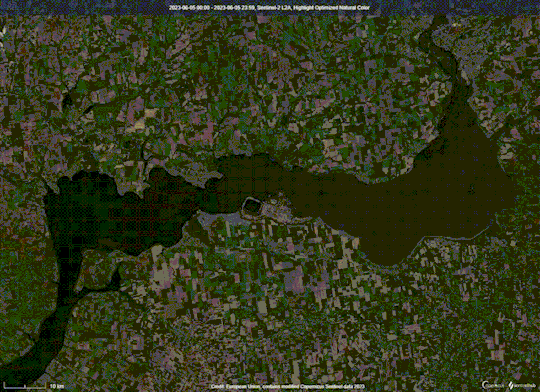
According to new satellite images, the Kakhovka Reservoir no longer exists. The Dnipro River has returned to its old course, and a desert with isolated lakes has formed in the center of Ukraine. A comparison of images before and after the destruction of the Kakhovka hydroelectric dam by the Russian occupiers was posted by the War Mapper account.
Commentators are discussing whether this situation will open up additional opportunities for the Ukrainian army to force the already narrow Dnipro River in a place unexpected by the enemy, but it seems that this area will be impassable for heavy military equipment for a long time.
There is no need to talk about the water supply in the South of Ukraine and the powerful blow to the region's ecology. The consequences of the destruction of the Kakhovka reservoir by the Russians can be equated to the use of nuclear weapons. The almost complete lack of reaction to this event by the UN and other countries directly pushes Russia to use real nuclear weapons and other crimes against humanity.
#ukraine#russia#war in ukraine#kakhovka dam#kakhovka hydroelectric power plant#kakhovka hpp#nova kakhovka dam#kakhovska dam#ecology#ecocide#russian war crimes#un
235 notes
·
View notes
Text
In Zaporozhye, russian terrorists launched a missile attack on the DneproGES dam.
They tried to blow it up in the same way as they blew up the dam of the Kakhovka hydroelectric power station in order to destroy the reservoir, cause a disaster and kill more civilians.
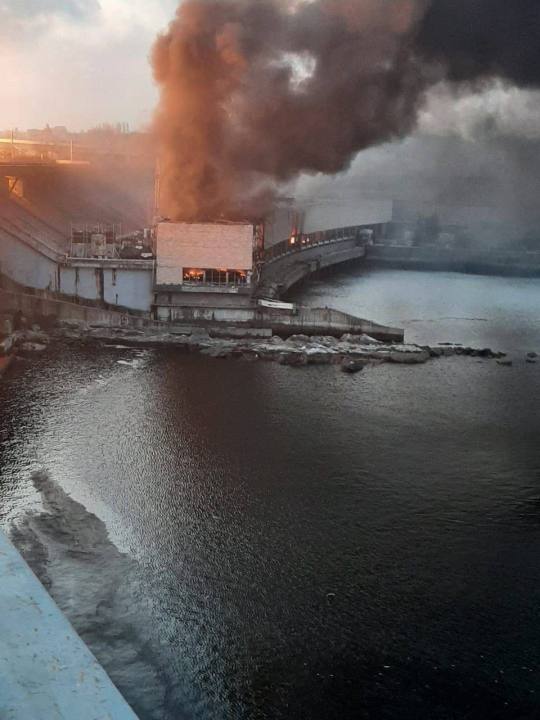

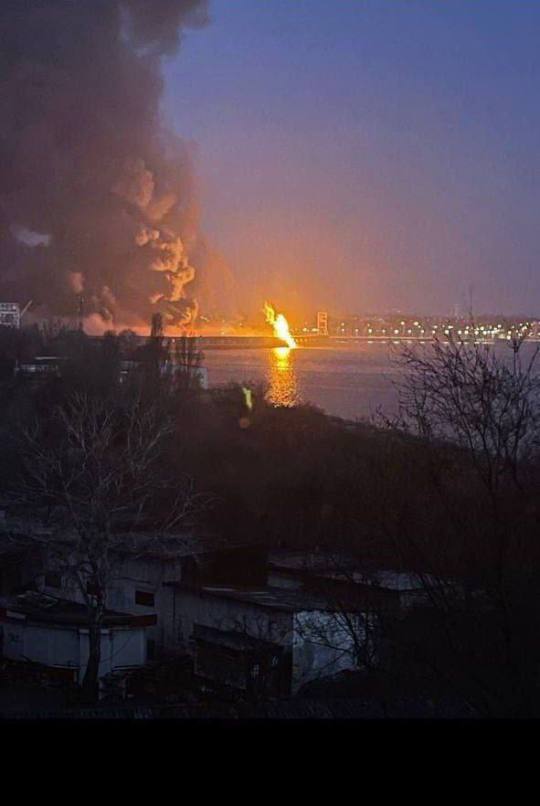
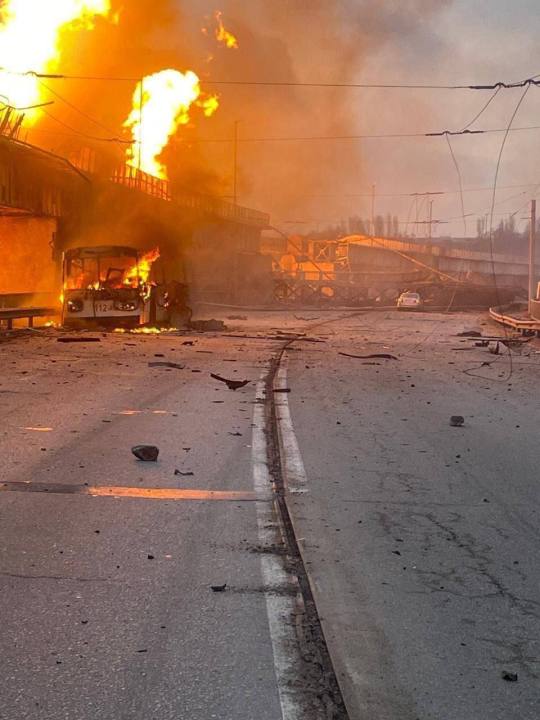
#russian terrorism#russian invasion in ukraine#russian crimes#russia is a terrorist state#russia terrorist state#russia invades ukraine#russia is the occupier#russian invasion#ukraine war#ukraine#standwithukraine#stand with ukraine
42 notes
·
View notes
Text
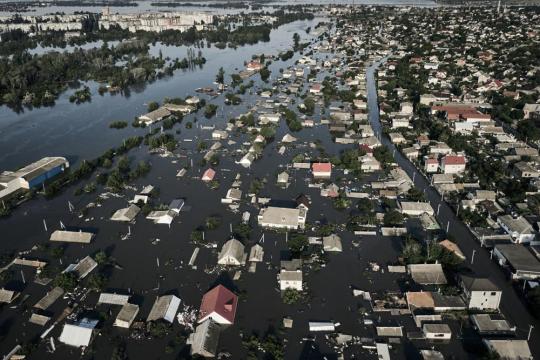
Streets are flooded in Kherson, Ukraine, Wednesday, June 7, 2023 after the walls of the Kakhovka dam collapsed. Residents of southern Ukraine, some who spent the night on rooftops, braced for a second day of swelling floodwaters on Wednesday as authorities warned that a Dnieper River dam breach would continue to unleash pent-up waters from a giant reservoir. (AP Photo/Libkos)

Russian rockets are launched against Ukraine from Russia's Belgorod region, seen from Kharkiv, Ukraine, late Sunday, June 4, 2023. (AP Photo/Vadim Belikov)

Volunteers evacuate dogs and goats from the flooded city in Kherson, Ukraine, Wednesday, June 7, 2023. Floodwaters from a collapsed dam kept rising in southern Ukraine on Wednesday, forcing hundreds of people to flee their homes in a major emergency operation that brought a dramatic new dimension to the war with Russia, now in its 16th month. (AP Photo/Libkos)

A woman identifying the body of her 34-year-old daughter, who was killed in an overnight missile strike in Kyiv on Thursday, June 1, 2023. (Nicole Tung/The New York Times)

Local resident Tetiana holds her pets, Tsatsa and Chunya, as she stands inside her house that was flooded after the Kakhovka dam blew up overnight, in Kherson, Ukraine, Tuesday, June 6, 2023. Ukraine on Tuesday accused Russian forces of blowing up a major dam and hydroelectric power station in a part of southern Ukraine that Russia controls, risking environmental disaster. (AP Photo/Evgeniy Maloletka)

People look at a fire on the top of residential building following a drone attack, in Kyiv, Ukraine, Saturday, May 20, 2023. Russian air attacks have escalated to near-nightly raids over the last month. The attacks come at night, when most in Kyiv are sound asleep. The sirens wail across the Ukrainian capital, rousing bleary-eyed residents, who, after 15 months of war, have customized individual routines to cope with Russia’s latest air campaign. (AP Photo/Alex Babenko)
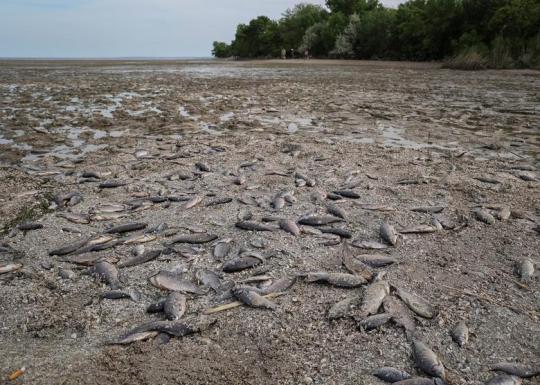
Dead fish are seen on the drained bottom of the Nova Kakhovka reservoir after the Nova Kakhovka dam breached in the village of Marianske in Dnipropetrovsk region, Ukraine, Wednesday, June 7, 2023. (REUTERS/Sergiy Chalyi)

Children attend a group therapy class at the recovery camp for children and their mothers affected by the war near Lviv, Ukraine, Wednsday, May 3, 2023. A generation of Ukrainian children have seen their lives upended by Russia's invasion of their country. Hundreds of kids have been killed. For the survivors, the wide-ranging trauma is certain to leave psychological scars that will follow them into adolescence and adulthood. UNICEF says an estimated 1.5 million Ukrainian children are at risk of mental health issues. (AP Photo/Vasilisa Stepanenko)
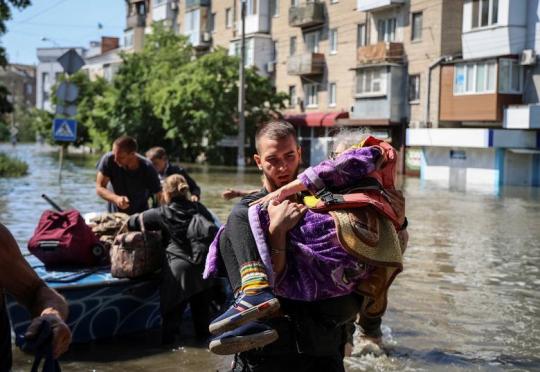
Police evacuate local residents from a flooded area after the Nova Kakhovka dam breached in Kherson, Wednesday, June 7, 2023 (REUTERS/Ivan Antypenko)

Ukrainian emergency workers wearing radiation protection suits attend training in Zaporizhzhia, Ukraine, Wednesday, June 7, 2023. The Zaporizhzhia Nuclear Power Plant, Europe’s biggest, relies in large part on water from the now-emptying reservoir at the Kakhovka dam. The U.N.’s International Atomic Energy Agency reported “no immediate risk to the safety of the plant,” whose six reactors have been shut down for months but still need water for cooling. (AP Photo/Andriy Andriyenko)
#war in ukraine#russian world#i know the last post i made was a month ago#but i honestly had a 'block' bc even if i post these pics what difference does it make?#the ppl who rb are ukrainians and the ppl who know what r*ssia is#the rest just have the luxury not to care#and that pisses me off so bad#im just tired and angry#i want ukraine to win and r*ssia to be sent to mars or wherever so i never have to hear from them again#i want them to fck off once and for all
215 notes
·
View notes
Text
Russia uses environmental terrorism in war against Ukraine

Andriy Yermak, head of the Ukrainian presidential administration, said, “At 2:50am this morning, Russian troops blew up the Kakhovka hydroelectric Station and its dam [which supplies water to Ukraine's Crimean peninsula and the Zaporizhzhia nuclear plant], flooding a swathe of the war zone and forcing villagers to flee.
"The explosion came from within. We know that Russian troops had mined the hydroelectric Station in the early days of the full-scale invasion, so the pre-meditated blast is the only plausible explanation.”
Senior advisor Dasha Zarivna said, “The dam bombing is another unprecedented Russian war crime against Ukraine, which will have catastrophic consequences both for its population and other countries. These include environmental and economic consequences, a great risk from radiation, and further serious disruption to food security. Last October, President Zelenskiy said, ‘All the world leaders should let Russia understand that a terrorist attack on the Kakhovka hydroelectric station will be equated to the use of weapons of mass destruction.' Now it has happened. World leaders must recognize the equivalence, and now must act decisively. It is essential to isolate the terrorist state as completely as possible. Any economic ties with Russia outside of humanitarian activities should be regarded as complicity in its war crimes.”
the vast reservoir behind the dam is one of the main geographic features of southern Ukraine, 240 kilometers (150 miles) long and up to 23 km wide, and a huge swathe of countryside lies in the flood plain below
more on The Guardian: X
198 notes
·
View notes
Text
I was six or seven when I first saw the sea. We went on a roadtrip to the Crimea. From the North of Ukraine to the very opposite end of the country. As my dad's old beige car that he long since had gotten rid of climbed a hill near Nova Kakhovka, I saw the great azure expanse of water. It spread as far as eye could see flowing endlessly into the horizon. Seagulls soared above it like tiny white specs.
I yelled:
"Mom, Dad, look! The Sea!"
They laughed and told me it was just the reservoir. The real thing was still a few hours ahead.
I still remember this moment to this day. More than 20 years in the past. And I want to keep remembering it like that — a nice city of green and blue with a funny-looking road police station shaped like a flying saucer.
101 notes
·
View notes
Text
A wave with a height of 4-5 m will hit the Antonivsky bridge east of Kherson after 7 p.m. After that, the water will rise up the Ingulets River, and after 4-5 days - the water will rise up the Bug River to Mykolaiv.
Several smaller towns and villages on both sides of the Dnieper will be flooded, and when the wave reaches them, it can be very dangerous and cause human casualties.
The isthmus at the end of the bay outside the Dnieper delta (Kinbourn spit) will be heavily flooded and almost completely submerged, although this will begin approximately 50 hours after the dam breach.
❗️Demolition of the dam in Nova Kakhovka by the Russian Federation terrorist forces
is a war crime according to the Geneva Convention.
The destruction of hydroelectric power plants is considered a weapon of mass destruction and a war crime of indiscriminate action, according to Article 56 of Additional Protocol I of 1977.
Secondary effects:
❗️Zaporizka NPP
The supply of cooling water to Europe's largest nuclear power plant, ZANP, which requires cooling even for shut-down reactors, is likely to stop.
❗️ North Crimean Channel
The supply of water to Crimea will stop again. Simply, a shot in the foot. They were going to stay there for a long time. Or not?
❗️ Reclamation of Tavria and the Kakhovsky Canal
The supply of water to the field irrigation systems of the Kherson, Dnipropetrovsk, and Zaporizhia regions will be stopped, and mainly on the occupied lands. It is not clear whether processing is currently taking place there, but without water it will definitely lose its meaning.
Many cities and villages that consume it from the Kakhovsky Canal will remain without drinking water, in particular occupied Berdyansk.
❗️ Kryvyi Rih
The 600,000-strong industrial city consumed 70% of its drinking water from the Kakhovsky Reservoir - now there will be difficulties with this.
❗️ Factories
Without a sufficient amount of water, the work of large industrial enterprises of the metallurgical industry in Marhanka, Nikopol, and Pokrov will have to be stopped.
❗️ Demographics
According to the information of the ecologist Maksym Soroka, up to 400,000 refugees affected by the dam explosion and, in the long term, up to 1,500,000 climate refugees may arrive in other regions in the near future.
❗️ Ecology is the worst!
A one-time reduction of water in a huge reservoir will lead to unpredictable ecological consequences: the death of a large number of fish, waterlogging of drained lands and a change in the climatic regime of the region.
⭕️ On the other hand, the sandy bottom will open and we will get a new desert with all the climatic consequences, such as a decrease in precipitation, dust storms, and a rise in temperature in the region. And accordingly, the risk of drought in the fields of central and southern Ukraine is greater.
The lack of water in the Kakhovsky Sea will lead to the drying of the fields of southern Ukraine with further desertification. The Zaporizhzhia NPP and dozens (if not hundreds) of large factories will have to be closed, which will not have enough water and electricity for production processes.
Accordingly, the population will leave this region en masse due to the impossibility of living in difficult climatic conditions and due to the lack of water and jobs.
54 notes
·
View notes
Text
The wall of a major dam in southern Ukraine collapsed Tuesday, triggering floods, endangering Europe’s largest nuclear power plant and threatening drinking water supplies as both sides in the war rushed to evacuate residents and blamed each other for the destruction.
Ukraine accused Russian forces of blowing up the Kakhovka dam and hydroelectric power station on the Dnieper River in an area that Moscow controls, while Russian officials blamed Ukrainian bombardment in the contested area. It was not possible to verify the claims.
The potentially far-reaching environmental and social consequences of the disaster quickly became clear as homes, streets and businesses flooded downstream and emergency crews began evacuations; officials raced to check cooling systems at the Zaporizhzhia Nuclear Power Plant; and authorities expressed concern about supplies of drinking water to the south in Crimea, which Russia illegally annexed in 2014.
Both Russian and Ukrainian authorities brought in trains and buses for residents. About 22,000 people live in areas at risk of flooding in Russian-controlled areas, while 16,000 live in the most critical zone in Ukrainian-held territory, according to official tallies. Neither side reported any deaths or injuries.
The dam break added a stunning new dimension to Russia’s war in Ukraine, now in its 16th month. Ukrainian forces were widely seen to be moving forward with a long-anticipated counteroffensive in patches along more than 1,000 kilometers (621 miles) of front line in the east and south.
It was not immediately clear whether either side benefits from the damage to the dam, since both Russian-controlled and Ukrainian-held lands are at risk. The damage could also hinder Ukraine’s counteroffensive in the south and distract its government, while Russia depends on the dam to supply water to Crimea.
Patricia Lewis, director of the International Security Program at Chatham House think tank in London, said apportioning blame is difficult but “there are all sorts of reasons why Russia would do this.”
“There were reports (last fall) of Russians having mined the reservoir. The question we should pose is why the Ukrainians would do this to themselves, given this is Ukrainian territory,” she said.
Experts have previously said the dam was suffering from disrepair. David Helms, a retired American scientist who has monitored the reservoir since the start of the war, said in an e-mail that it wasn’t clear if the damage was deliberate or simple neglect from Russian forces occupying the facility.
But Helms reserved judgement, also noting a Russian history of attacking dams.
Authorities, experts and residents have expressed concern for months about water flows through — and over — the Kakhovka dam. After heavy rains and snow melt last month, water levels rose beyond normal levels, flooding nearby villages. Satellite images showed water washing over damaged sluice gates.
Amid official outrage, Ukrainian President Volodymyr Zelenskyy said he convened an urgent meeting of the National Security Council. He alleged Russian forces set off a blast inside the dam structure at 2:50 a.m. (2350 GMT Monday) and said about 80 settlements were in danger. Zelenskyy said in October his government had information that Russia had mined the dam and power plant.
But Kremlin spokesman Dmitry Peskov called it “a deliberate act of sabotage by the Ukrainian side … aimed at cutting water supplies to Crimea.”
Both sides warned of a looming environmental disaster. Ukraine’s Presidential Office said some 150 metric tons of oil escaped from the dam machinery and that another 300 metric tons could still leak out.
Andriy Yermak, the head of Ukraine’s President’s Office, posted a video showing swans swimming near an administrative building in the flooded streets of Russian-occupied Nova Kakhovka, a city in the Kherson region where some 45,000 people lived before the war. Other footage he posted showed flood waters reaching the second floor of the building.
Ukraine’s Interior Ministry urged residents of 10 villages on the Dnieper’s right bank and parts of the city of Kherson downriver to gather essential documents and pets, turn off appliances, and leave, while cautioning against possible disinformation.
The Russian-installed mayor of occupied Nova Kakhovka, Vladimir Leontyev, said it was being evacuated as water poured into the city.
Ukraine’s nuclear operator Energoatom said in a Telegram statement that the damage to the dam “could have negative consequences” for the Zaporizhzhia Nuclear Power Plant, which is Europe’s biggest, but wrote that for now the situation is “controllable.”
The U.N.’s International Atomic Energy Agency said in a statement there was “no immediate risk to the safety of the plant,” which requires water for its cooling system.
It said that IAEA staff on site have been told the dam level is falling by 5 centimeters (2 inches) an hour. At that rate, the supply from the reservoir should last a few days, it said.
The plant also has alternative sources of water, including a large cooling pond than can provide water “for some months,” the statement said.
Ukrainian authorities have previously warned that the dam’s failure could unleash 18 million cubic meters (4.8 billion gallons) of water and flood Kherson and dozens of other areas where thousands of people live.
The World Data Center for Geoinformatics and Sustainable Development, a Ukrainian nongovernmental organization, estimated that nearly 100 villages and towns would be flooded. It also reckoned that the water level would start dropping only after five-seven days.
A total collapse in the dam would wash away much of the broad river’s left bank, according to the Ukraine War Environmental Consequences Working Group, an organization of environmental activists and experts documenting the war’s environmental effects.
Mykhailo Podolyak, a senior adviser to President Volodymyr Zelenskyy, said that “a global ecological disaster is playing out now, online, and thousands of animals and ecosystems will be destroyed in the next few hours.”
Video posted online showed floodwaters inundating a long roadway; another showed a beaver scurrying for high ground from rising waters.
The incident also drew international condemnation, including from German Chancellor Olaf Scholz and NATO Secretary-General Jens Stoltenberg, who said the “outrageous act … demonstrates once again the brutality of Russia’s war in Ukraine.”
Ukraine controls five of the six dams along the Dnieper, which runs from its northern border with Belarus down to the Black Sea and is crucial for the country’s drinking water and power supply.
Ukraine’s state hydro power generating company wrote in a statement that “The station cannot be restored.” Ukrhydroenergo also claimed Russia blew up the station from inside the engine room.
Leontyev, the Russian-appointed mayor, said numerous Ukrainian strikes on the Kakhovka hydroelectric plant destroyed its valves, and “water from the Kakhovka reservoir began to uncontrollably flow downstream.” Leontyev added that damage to the station was beyond repair, and it would have to be rebuilt.
Ukraine and Russia have previously accused each other of targeting the dam with attacks.
58 notes
·
View notes
Photo


DP-64: Russia's Anti-Saboteur Grenade Launcher In Ukraine
Designed to combat the threat of Frogmen/Combat Divers, the DP-64 is a niche-role 45mm grenade launcher. In March it was featured in a Russian news report filmed somewhere in the region of the Kakhovka Reservoir.
youtube
Check out the accompanying article here.
72 notes
·
View notes
Text





The Ukraine Kakhovka Reservoir one year after the destruction of the Kakhovka Dam in 2023 during the Ukraine war.
"The Great Meadow has returned."
Ukraine War
dumskaya.net/
8 notes
·
View notes
Text
This is what the Kakhovka reservoir looks like now after the Russian occupiers blew up the Kakhovka Hydroelectric Power Plant. The former "sea" has become a desert, its bottom has almost completely dried up and is covered with a fine network of cracks.






#ukraine#russia is a terrorist state#russia invades ukraine#russian war crimes#russia ukraine war#russian invasion#russian agression#russian terrorism#russia must burn#fuck russia#russia
312 notes
·
View notes
Text
Zaporizhzhia nuclear plant reports drone attack from Ukraine: Jeremiah 12
The Zaporizhzhia nuclear power plant, Europe’s largest, is seen in the background of the shallow Kakhovka Reservoir after the dam collapse, in Energodar, June 27, 2023. (PHOTO / AP) By Xinhua MOSCOW – A training center building of the Zaporizhzhia nuclear power plant (ZNPP) was attacked by a Ukrainian drone on Sunday, according to the plant’s press service. “A Ukrainian drone hit the roof of…

View On WordPress
#Andrew the Prophet#andrewtheprophet#nuclear#Russia#the prophecy#theprophecy#ukraine#War#zapozaporizhzhia
2 notes
·
View notes
Text
please help donate to save people flooded after the destruction of the Kakhovka dam 🙏🙏
43 notes
·
View notes